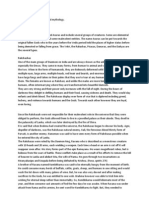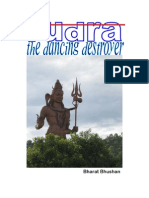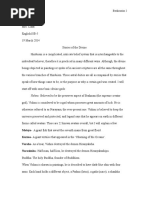Ganna Chakra - The Ganas - Hooligans of Heaven
Ganna Chakra - The Ganas - Hooligans of Heaven
Uploaded by
Sabina SerbanCopyright:
Available Formats
Ganna Chakra - The Ganas - Hooligans of Heaven
Ganna Chakra - The Ganas - Hooligans of Heaven
Uploaded by
Sabina SerbanOriginal Description:
Original Title
Copyright
Available Formats
Share this document
Did you find this document useful?
Is this content inappropriate?
Copyright:
Available Formats
Ganna Chakra - The Ganas - Hooligans of Heaven
Ganna Chakra - The Ganas - Hooligans of Heaven
Uploaded by
Sabina SerbanCopyright:
Available Formats
The Ganas: Hooligans of Heaven
by Ganna Chakra
The Ganas (categories) are the host of spooks, hobgoblins and spirits who accompany Shiva. Some are said to dwell with him on Mount Kailasa, whilst the more fearsome and terrifying Ganas are confined to the cremation grounds. It is told that Uma once asked Lord Shiva why he liked to reside in cremation grounds, which were the abode of demons, jackals, corpses and vultures, when he had so many more beautiful places. Mahesvara replied that he had roamed the world, looking for a pure place to meditate in. Unable to find one, he, out of anger and frustration, he created the terrible pishachas, flesh-eating ghouls and terrible rakshasas, intent on killing people. Out of compassion however, he kept this terrible horde in the cremation ground. As he did not want to live without the bhutas and ganas, he chose to live in a cemetery. When the ghosts stayed with him, they caused no harm. The presence of the terrible Ganas also acted as an honour guard to Shiva and a bar to the impure. Those who feared the awful ghosts and goblins were destined to remain outsiders. Only heroes could be near him in the cremation ground, heroes who had defied death and liberated themselves from passions and fear. These were the true devotees - those who had nothing to fear, who had mastered the onslaught of the multiple categories of threatening powers that were fatal to those who were less than heroes and could not control the frightening phantoms because they had not controlled themselves. In one sense, the Ganas can be thought of as emanations of Shiva. They are described by Stella Kramrisch in her book The Presence of Shiva as "prognostications or caricatures of possibilities of the human condition." Whilst some of them were created by Shiva, others attained the status of Ganas after being defeated in battle by Shiva.
Myths in which the Ganas appear
Ganesha One version of the birth of Ganesha tells of how Ganesha was created by Parvati to act as a dvarlapala - a guardian of her threshold. When Shiva came to his wife's apartments, not only did Ganesha refuse to admit him, he had the audacity to strike Shiva. Shiva ordered his bhutaganas to kill Ganesha. Not only did Ganesha successfully oppose the ganas, he also defeated all the gods who came to their help. With the help of Vishnu's power to create a dazzling illusion, the gods managed to take Ganesha unawares, and struck off his head. Parvati, furious at this, began to fight Shiva herself. Eventually, Paravti agreed to make peace, on the condition that her son was restored to life. Shiva agreed and ordered the devatas to travel north and bring back the head of the first animal they came across - which happened to be the head of an elephant. Thus Ganesha was restored to life and Shiva, impressed at his fighting prowess, made him chief of his troops, the Ganas.
Jalandhara In the myth of the Daitya king Jalandhara, Jalandhara sends Rahu with a message to Shiva, demanding that he surrender Parvati to Jalandhara. Shiva was angry at this message, and this anger took the form of a terrible creature which sprang from his brow. It had the face of a lion, flaming eyes, a body which was dry and rough to the touch, long arms and a tongue which lolled with anger. The creature rushed at Rahu, ready to devour him. Shiva apparently said something along the lines of "we don't shoot the messenger" whereon the gana pleaded to Shiva that it was tortured by hunger. Shiva told the gana that if it was so hungry, it should eat its own flesh. This the gana did, until only its head was left. Shiva, pleased with such devotion, appointed the gana as his door-keeper, ordering that it create terror for all wicked people. Shiva also ordained that the gana be worshipped along with his worship, and gave it the name Kirtimukha. Jalandhara was furious when he heard what had transpired and commanded his army of daityas to beseige Mt. Kailash. A fierce battle broke out between the diatyas and the ganas. But each time that a daitya was killed, it was revived immediately by their preceptor, Shukra. The ganas told Shiva about this and he was furious. A terrible form called Kritya came forth from his mouth. Her calves were as stout as trees and her mouth was huge and deep like a mountain cavern. She rushed upon the battlefield and began to devour the enemy. She was so big and strong that a push from her breasts uprooted trees and the earth split beneath her feet. She picked up Shukra, stuffed him into her vagina, and vanished. When Shukra was seized, the daityas were frightened and were scattered from the battlefield. In another version of the Jalandhara myth, Shukra is swallowed by Shiva himself. Shukra spent hundreds of years wandering round in the belly of Shiva. Finally he resorted to the Yoga of Shiva and, after repetition of a special mantra, asssumed the form of Shiva's semen and emerged out of the god's body through his penis. He bowed to Shiva and Parvati accepted him as her son. Shiva made him a chief among his ganas. Andhaka In a related myth, Andhaka, king of the Daityas, is defeated by Shiva and made into a leader of his ganas. This is however, somewhat complicated by the fact that Andhaka is a son of Shiva & Parvati, born when Parvati, in play, placed her hands over Shiva's eyes. The contact of her hands over his eyes brought forth perspiration, from which was born a terrifying-looking creature. Ungrateful, with a bad temper, blind, deformed, and black in colour. He had hair all over his body, matted locks, and behaved like a madman. Shiva named this being Andhaka and ordered his ganas to guard him. Shiva was later approached by the daitya Hiranyasksha, who performed many penances in order that Shiva grant him the boon of a son. Shiva gave Hiranyaksha Andhaka to be his adopted son. Vishnu, in his form of Varaha the Boar, warred with and finally destroyed Hiranyaksha, crowning Andhaka as chief of the daityas. Descriptions of the Ganas vary from the wholly abstract representing the fundamental categories of existence, to somewhat negative descriptions of them being deformed, grotesque, dwarfs or night-walking spirits of gross and lustful appetite. It is said they had acquired the capacity to change shapes whenever they liked, could move about invisibly and fly. They flung
Shiva's enemies into ravines and dashing them to the ground in their rage. Moreover, they were fond of music and dancing, and occasionally enticed women into their embrace. The Pishachas were often propitiated by people in order that they spare children from their attentions. In some myths, Skanda was originally reckoned as among the Pishacha hosts. However, it was also deemed possible for human beings to become Ganas. From Indian Witchcraft by R.N Saletore comes a description of the ganas: "...a princess Rupinika was advised how to look like a Gana. She had to shave her head with a razor in such a manner that five locks were to be left, then she was to wear a necklace around her neck of skulls and stripping off her clothes, paint one side of her body with lamp-black and the other with red lead so that in this way she could resemble a Gana and find it easy to gain admission into heaven." In her book Shiva, Shakti M. Gupta provides a long description of the ritual of Mahashivaratri the Festival of Repentance, which falls on the 14th night of the New Moon, during the dark half of the lunar month of Phalguna. It is said that one who performs this sacrifice successfully, with all the rituals & rules laid down, obtains his most cherished desires, achieves liberation, and is accepted as one of Shiva's Ganas dwelling on Mt. Kailas. The image of Shiva in the cremation-ground, surrounded by ganas, ghosts, goblins and ghouls, offers a paradigm for his devotees, and the sadhana (practice) associated with the cremationground is highly prevalent in Tantra. In essence, the heroic devotee, by practising the rites of the cremation-ground, emulates Shiva and becomes one of his family of ganas or becomes Shiva and is lord of his or her own categories. In some regions of India, the Nathas are identified with the hosts of Ganas. Alain Danilou, in Gods of Love and Ecstasy likens the Ganas to both the Greek Korybantes (supernatural followers of Dionysus) and the Celtic Korrigans (fairies' sons) or the Wild Hunt. He notes that the followers of the god tend to identify themselves with his heavenly companions and to imitate their behaviour. In ancient Greece, the Korybantes were imitated by the Kouretes. Danielou notes that the practitioners of the ecstatic rites of Shiva were called bhaktas - which he translates as "participants" and says there is no difference in concept or practice between the Dionysiac bacchantes and the Shivaite bhaktas. He notes that a hymn in the Rig Veda describes the mad ones who are wild and naked, having drunk from Rudra's cup. According to Danielou, the Ganas mock the rules of ethics and social order - they personify the joys of living, courage and imagination. "These delinquents of heaven are always there to restore true values and to assist the "god-mad" who are persecuted and mocked by the powerful. They personify everything which is feared by and displeases bourgeois society..."
Notes for Magical Work
It is interesting to note how many ganas etc., are born out of the anger or rage of the gods. The myths of the creation of Kali or Durga would be apposite examples also. The name Rudra - the primal form of Shiva - means to howl or cry out. These manifestations are spontaneous, rather than willed acts of creation on the part of Shiva. Kramrisch notes that the anger of Shiva was a
creative component of his samadhi. The premise which we have chosen to work from initially, is that Shiva as the archetypal Yogimagician has not repressed or willed his desire-forms into silence - he manifests them spontaneously, regards them as separate beings, and acknowledges them, as can be seen in the case of the Gana Kirtimukha, above. This suggests ideas for working with our own complexes of desire-forms/demons - i.e. to allow them free reign, grant them name & form, acknowledge them as born of us - rather than trying to banish or suppress. This I feel is rather like saying "yes I am jealous, paranoid, stupid, mistaken etc., sometimes - these are true parts of me" rather than trying to cling to some idealised view of self or what self should be. This approach can be viewed as part of the sadhana of Klesha-smashing.
You might also like
- Gita Makaranda by Swami VidyaprakashanandaDocument1,129 pagesGita Makaranda by Swami VidyaprakashanandaPramod96% (24)
- Awakening Shakti: The Transformative Power of the Goddesses of YogaFrom EverandAwakening Shakti: The Transformative Power of the Goddesses of YogaRating: 4.5 out of 5 stars4.5/5 (10)
- Guru Gita (Hindi) FullDocument39 pagesGuru Gita (Hindi) Fullapi-2650240490% (39)
- The Secret of The NagasDocument3 pagesThe Secret of The NagasMuthumanikandan Hariraman25% (4)
- Ganna Chakra - The Ganas - Hooligans of Heaven PDFDocument4 pagesGanna Chakra - The Ganas - Hooligans of Heaven PDFamane72No ratings yet
- Stories From The Puranas RetoldDocument18 pagesStories From The Puranas RetoldAnonymous Gb9LeJcINo ratings yet
- Deva Archana Advaita BhakthiDocument53 pagesDeva Archana Advaita Bhakthiraghavendra8533936No ratings yet
- Phil Hine - Tantrum MagickDocument4 pagesPhil Hine - Tantrum MagickMihai BuşeNo ratings yet
- Bhairava The WrathfulDocument7 pagesBhairava The Wrathfulandrijaandrija50% (2)
- What Is Shivling - VedKaBhed - Com BackupDocument24 pagesWhat Is Shivling - VedKaBhed - Com Backupfarhanzafarmorse045No ratings yet
- Mandalamyths: Relaxing Mandalas and Mythological StoriesFrom EverandMandalamyths: Relaxing Mandalas and Mythological StoriesNo ratings yet
- GANESADocument37 pagesGANESANguyen Hai HoangNo ratings yet
- Shiva: Written byDocument8 pagesShiva: Written bySharanu HolalNo ratings yet
- Parvati ArticleDocument8 pagesParvati Articlejmullinder100% (1)
- Shiv YogDocument238 pagesShiv YogKishoreBijja100% (3)
- Hindu DemonsDocument5 pagesHindu DemonsMrBond666No ratings yet
- Rudra: Written byDocument23 pagesRudra: Written bySharanu Holal100% (1)
- Ayyappan CultDocument13 pagesAyyappan CultVedic Saagar100% (1)
- Mahavidyas PDFDocument17 pagesMahavidyas PDFMetcher Maa Akhi100% (1)
- Nāga - WikipediaDocument10 pagesNāga - Wikipediajorge soliese100% (1)
- Das MahaVidyasDocument36 pagesDas MahaVidyaskiran_vedante100% (1)
- Ganesha: Lord of Success: Vaivarta Purana: Shiva Asked Parvati To Observe The Punyaka Vrata For A Year ToDocument6 pagesGanesha: Lord of Success: Vaivarta Purana: Shiva Asked Parvati To Observe The Punyaka Vrata For A Year TosiewfeiNo ratings yet
- AvatarsDocument14 pagesAvatarsAmlan Dutta100% (1)
- Nandi (Bull)Document5 pagesNandi (Bull)Nitin ShekharNo ratings yet
- Stories From The PuranasDocument170 pagesStories From The PuranasSunil KulkarniNo ratings yet
- Maha ShivaratriDocument7 pagesMaha ShivaratricatchdgreenNo ratings yet
- Sexual Pervert Hindu God SHIVADocument9 pagesSexual Pervert Hindu God SHIVAchikpi.z4No ratings yet
- Ganesha EmpowermentDocument8 pagesGanesha Empowermentkoochi44100% (2)
- Kala BhairavDocument5 pagesKala BhairavAred Mosinel100% (1)
- Das MahaVidyasDocument45 pagesDas MahaVidyasVishnu Kumar GuptaNo ratings yet
- The Sons of Lord SivaDocument17 pagesThe Sons of Lord SivaNarayanan Muthuswamy67% (3)
- Kuldevi Shri Siddhambika Matahe Namah!!!Document8 pagesKuldevi Shri Siddhambika Matahe Namah!!!Sagar TiwariNo ratings yet
- The Story of GaneshDocument16 pagesThe Story of GaneshudayNo ratings yet
- Mahabaratha Tatparya Nirnaya: - Introduction by Prof.K.T.PandurangiDocument4 pagesMahabaratha Tatparya Nirnaya: - Introduction by Prof.K.T.PandurangiHarsha AcharNo ratings yet
- Shiva to Shankara: Giving Form to the FormlessFrom EverandShiva to Shankara: Giving Form to the FormlessRating: 2.5 out of 5 stars2.5/5 (13)
- Scriptural References To KaliDocument7 pagesScriptural References To KaliVignesh JayanNo ratings yet
- 1.6 MatangiDocument8 pages1.6 MatangiallandzxNo ratings yet
- Lakshmi HayagrivaDocument16 pagesLakshmi HayagrivaT Sampath KumaranNo ratings yet
- Look at The Different Pictures of God and Goddesses of Hindu, Give A Brief Explanation of Each God and GoddessesDocument6 pagesLook at The Different Pictures of God and Goddesses of Hindu, Give A Brief Explanation of Each God and GoddessesAsuna SmithNo ratings yet
- Story of The Origin of The Das MahavidyasDocument7 pagesStory of The Origin of The Das MahavidyasAakash AhujaNo ratings yet
- Stories From The PuranasDocument172 pagesStories From The PuranasSachin SinghalNo ratings yet
- Asura TemplesDocument24 pagesAsura Templesdivyanshurai125No ratings yet
- Indian MythologyDocument37 pagesIndian MythologyMich Del RosarioNo ratings yet
- Legends: Sanskrit Hindu Shiva MendicantDocument6 pagesLegends: Sanskrit Hindu Shiva MendicantnieotyagiNo ratings yet
- Gods and Goddesses of HinduismDocument3 pagesGods and Goddesses of HinduismZero TwoNo ratings yet
- Articles by DevDuttDocument170 pagesArticles by DevDuttKumar Ganesh100% (1)
- ASURASDocument6 pagesASURASRAGHAVACHARY SridharNo ratings yet
- RudraDocument50 pagesRudraAntonio SilvazaNo ratings yet
- BhairavaDocument11 pagesBhairavaYash TrivediNo ratings yet
- Stories of Shiva and ParvatiDocument33 pagesStories of Shiva and ParvatiDivyaK007100% (1)
- Essay 4 EnglishDocument3 pagesEssay 4 Englishapi-318926549No ratings yet
- Story of Sagara ManthanDocument12 pagesStory of Sagara Manthanfarzana25No ratings yet
- Untold Stories of ShivaDocument2 pagesUntold Stories of Shivabajajanushka2012No ratings yet
- 4 Dancing Ganesha Author The Art Institute of ChicagoDocument12 pages4 Dancing Ganesha Author The Art Institute of ChicagoD psNo ratings yet
- Story of Indian Divinity-Evolution of UniverseDocument13 pagesStory of Indian Divinity-Evolution of UniverseSnehil Sharma0% (1)
- KalimataDocument8 pagesKalimataSunil HasnaleNo ratings yet
- LalitopakhyanamDocument44 pagesLalitopakhyanamAbhijna Shivapuram100% (5)
- The Changing Faces of An Elephant Headed DivinityDocument3 pagesThe Changing Faces of An Elephant Headed DivinityVerb8No ratings yet
- Hindu Law: IndoDocument47 pagesHindu Law: Indoqtronix1979No ratings yet
- Vishnu Sahasranama - Naval Kishore PressDocument44 pagesVishnu Sahasranama - Naval Kishore PressAdya TripathiNo ratings yet
- 13 Sonal Makhija - Bar Dancers, Morality and The Indian LawDocument4 pages13 Sonal Makhija - Bar Dancers, Morality and The Indian LawSaurav DattaNo ratings yet
- G T Deshpande - AbhinavaguptaDocument183 pagesG T Deshpande - Abhinavaguptaaaro_oraal100% (5)
- Do Vedic Yajnas Really Induce Rain?Document3 pagesDo Vedic Yajnas Really Induce Rain?vijaychemuturi100% (1)
- Ciphering The Supreme - Mantric Encoding in Abhinavagupta's TantralokaDocument30 pagesCiphering The Supreme - Mantric Encoding in Abhinavagupta's Tantralokavkas100% (5)
- Bindu: Sri Krishna KathamritaDocument4 pagesBindu: Sri Krishna KathamritaAleksandr N ValentinaNo ratings yet
- Tamil Baby Names Starts With DDocument35 pagesTamil Baby Names Starts With Dkarthik arunmozhiNo ratings yet
- Dawatohindus 160208090827Document35 pagesDawatohindus 160208090827islamicdawah centerNo ratings yet
- Andre Van Lysebeth - Tantra - The Cult of The FeminineDocument382 pagesAndre Van Lysebeth - Tantra - The Cult of The FeminineSophia Leslie100% (13)
- 09 Hanseswari Temple BanshberiaDocument4 pages09 Hanseswari Temple BanshberiaSayan RoyNo ratings yet
- The Indian System of Varna (Caste System)Document14 pagesThe Indian System of Varna (Caste System)Joshua RomasantaNo ratings yet
- Difference Between North Indian and South Indian TemplesDocument4 pagesDifference Between North Indian and South Indian TemplesTanish BansalNo ratings yet
- Prameya RatnavaliDocument6 pagesPrameya RatnavaliAndreea SarcaniNo ratings yet
- Survey of Afro-Asian LiteratureDocument264 pagesSurvey of Afro-Asian LiteratureRona dela RosaNo ratings yet
- Sivananda e Alunos (IMPORTANTE)Document27 pagesSivananda e Alunos (IMPORTANTE)Hab Zahir MoraesNo ratings yet
- The Sankhya KarikaDocument277 pagesThe Sankhya KarikaGuyLeavitt100% (1)
- Evening Prayers: Himalayan Institute, 2016 1Document2 pagesEvening Prayers: Himalayan Institute, 2016 1Roberta PippiNo ratings yet
- Trishati BhashyamDocument3 pagesTrishati BhashyamParama PádaNo ratings yet
- 52 Yama and Pitars in Rig Veda God Yama: The God of Death and JusticeDocument6 pages52 Yama and Pitars in Rig Veda God Yama: The God of Death and JusticePankaj D PatelNo ratings yet
- Characterization and Humanism: A Study of Tagore's GoraDocument6 pagesCharacterization and Humanism: A Study of Tagore's GoraImpact JournalsNo ratings yet
- Soma Surya and PanchangaDocument2 pagesSoma Surya and PanchangaAstroSunilNo ratings yet
- Whitman and Indian MythsDocument12 pagesWhitman and Indian MythsZoobia AbbasNo ratings yet
- 108 Names of Maa DurgaDocument3 pages108 Names of Maa DurgaArjikuja AryaNo ratings yet
- Kali Santarana UpanisadDocument3 pagesKali Santarana UpanisadMurugesan RajuNo ratings yet
- Students Navasakam ListDocument13 pagesStudents Navasakam ListSri SriNo ratings yet
- Deepavalimalar - 2010.Document43 pagesDeepavalimalar - 2010.mvenkNo ratings yet

























































































